Short Answers
Q.1. The apparent weight of an object increases in an elevator while accelerating upward. A person sells peanuts using a beam balance in an elevator. Will he gain more if the elevator is accelerating up?
No, the accelerating elevator will affect the weight of both sides of the beam balance. So, the net effect of the accelerating elevator cancels out, and we get the actual mass.
Q.2. A boy puts a heavy box of mass M on his head and jumps from the top of a multi-storied building to the ground. What is the force exerted by the box on the boy's head during his free fall? Does the force greatly increase during the period he balances himself after striking the ground?
During free fall:
Acceleration of the boy = Acceleration of mass M = g
Acceleration of mass M w.r.t. boy, a = 0
So, the force exerted by the box on the boy's head = M × a = 0
Yes, the force greatly increases during the period he balances himself after striking the ground because of the weight of the box.
Q.3. A person drops a coin. Describe the path of the coin as seen by the person if he is in (a) a car moving at constant velocity and (b) in a free falling elevator.
When the person drops the coin, the path of coin as seen by the person if:
(a) In the car, the path of the coin will be vertically downward because the only force acting on the coin is gravity in the downward direction.
(b) In a free falling elevator, the coin as well as the person will be in a condition of weightlessness. So, the coin will remain stationary with respect to the person.
Because all fee falls objects weightlessness.
Q.4. Is it possible for a particle to describe a curved path if no force acts on it? Does your answer depend on the frame of reference chosen to view the particle?
If no force acts on the particle it cannot change its direction. So, it is not possible for a particle to describe a curved path if no force acts on it.
Yes, the answer depends on the frame of reference chosen to view the particle if the frame of reference describes a curved path.
Q.5. You are travelling in a car. The driver suddenly applies the brakes and you are pushed forward. Why does this happen?
We are pushed forward because of the inertia of motion, as our body opposes the sudden change.
Q.6. It is sometimes heard that the inertial frame of reference is only an ideal concept and no such inertial frame actually exists. Comment.
We can't find a body whose acceleration is zero with respect to all other bodies in the universe because every body in the universe is moving with respect to other bodies. As we live on earth which itself is accelerates due to its revolution around the sun and spinning about its own axis, so whatever observations and measurements ,we make , are w.r.t to earth which itself is not an inertial frame. Similarly all other planets are also in motion around the sun so ideally no inertial frame is possible.
Q.7. An object is placed far away from all the objects that can exert force on it. A frame of reference is constructed by taking the origin and axes fixed in this object. Will the frame be necessarily inertial?
Yes, if the force on the object is zero, its acceleration w.r.t. all the other objects will we zero. So, the frame will necessarily be an inertial frame.
Q.8. The figure shows a light spring balance connected to two blocks of mass 20 kg each. The graduations in the balance measure the tension in the spring. (a) What is the reading of the balance? (b) Will the reading change if the balance is heavy, say 2.0 kg? (c) What will happen if the spring is light but the blocks have unequal masses?

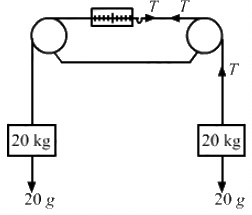
The reading of the balance = Tension in the string
And tension in the string = 20g
So, the reading of the balance = 20g = 200 N
(b) If the balance is heavy, the reading will not change because the weight of spring balance does not affect the tension in the string.
(c) If the blocks have unequal masses, the spring balance will accelerate towards the heavy block with an acceleration a. Then the reading will be equal to the tension in the string.
Suppose m1 > m2.
Then tension in the string,

Q.9. The acceleration of a particle is zero, as measured from an inertial frame of reference. Can we conclude that no force acts on the particle?
No. The acceleration of the particle can also be zero if the vector sum of all the forces is zero, i.e. no net force acts on the particle.
Q.10. Suppose you are running fast in a field and suddenly find a snake in front of you. You stop quickly. Which force is responsible for your deceleration?
The force of friction acting between my feet and ground is responsible for my deceleration.
Q.11. If you jump barefoot on a hard surface, your legs are injured. But they are not injured if you jump on a soft surface like sand or pillow. Why?
In both the cases, change in momentum is same but the time interval during which momentum changes to zero is less in the first case. So, by F = (dp/dt), force in the first case will be more. That's why we are injured when we jump barefoot on a hard surface.
Q.12. According to Newton's third law, each team pulls the opposite team with equal force in a tug of war. Then, why does one team win and the other lose?
The forces on the rope must be equal and opposite, according to Newton's third law. But not all the forces acting on each team are equal. The friction between one team and the ground does not depend on the other team and can be larger on one side than on the other. In addition, the grips on the rope need not be equal and opposite. Thus, the net force acting on each team from all sources need not be equal.
Q.13. A spy jumps from an airplane with his parachute. The spy accelerates downward for some time when the parachute opens. The acceleration is suddenly checked and the spy slowly falls to the ground. Explain the action of the parachute in checking the acceleration.
Air applies a velocity-dependent force on the parachute in upward direction when the parachute opens. This force opposes the gravitational force acting on the spy. Hence, the net force in the downward direction decreases and the spy decelerates.
Q.14. Consider a book lying on a table. The weight of the book and the normal force by the table in the book are equal in magnitude and opposite in direction. Is this an example of Newton's third law?
No, this is not an example of Newton's third law. According to Newton's law, if a body A exerts a force on body B, then B exerts a force on A equal in magnitude and opposite in direction. The forces act on different bodies. So, the normal by table on the book is action and the reaction pair is the force on a table by the book. Weight is due to the force of the earth on the book, not due to the table. Hence this is not an action-reaction pair.
Q.15. Two blocks of unequal masses are tied by a spring. The blocks are pulled stretching the spring slightly and the system is released on a frictionless horizontal platform. Are the forces due to the spring on the two blocks equal and opposite? If yes, is it an example of Newton's third law?
Yes, the forces due to the spring on the two blocks are equal and opposite.
But it's not an example of Newton's third law because there are three objects (2 blocks + 1 spring). Spring force on one block and force by the same block on the spring is an action-reaction pair.
Q.16. When a train starts, the head of a standing passenger seems to be pushed backward. Analyse the situation from the ground frame. Does it really go backward? Coming back to the train frame, how do you explain the backward movement of the head on the basis of Newton's laws?
No, w.r.t. the ground frame, the person's head is not really pushed backward.
As the train moves, the lower portion of the passenger's body starts moving with the train, but the upper portion tries to be in rest according to Newton's first law and hence, the passenger seems to be pushed backward.
Q.17. A plumb bob is hung from the ceiling of a train compartment. If the train moves with an acceleration 'a' along a straight horizontal track , the string supporting the bob makes an angle tan−1 (a/g) with the normal to the ceiling. Suppose the train moves on an inclined straight track with uniform velocity. If the angle of incline is tan−1 (a/g), the string again makes the same angle with the normal to the ceiling. Can a person sitting inside the compartment tell by looking at the plumb line whether the train is accelerating on a horizontal straight track or moving on an incline? If yes, how? If not, then suggest a method to do so.
No, a person sitting inside the compartment can't tell just by looking at the plumb line whether the train is accelerating on a horizontal straight track or moving on an incline.
When the train is accelerating along the horizontal, the tension in the string is  when it is moving on the inclined plane, the tension is mg. So, by measuring the tension in the string we can differentiate between the two cases.
when it is moving on the inclined plane, the tension is mg. So, by measuring the tension in the string we can differentiate between the two cases.
Multiple Choice Questions
Question for HC Verma Questions and Solutions: Chapter 5- Newton's Laws of Motion- 1
Try yourself:A body of weight w1 is suspended from the ceiling of a room by a chain of weight w2. The ceiling pulls the chain by a force.
Explanation
w1 + w2

From the free-body diagram,
(w1 + w2) – N = 0
N = w1 + w2
The ceiling pulls the chain by a force (w1 + w2).
Report a problem
Question for HC Verma Questions and Solutions: Chapter 5- Newton's Laws of Motion- 1
Try yourself:When a horse pulls a cart, the force that helps the horse to move forward is the force exerted by
Explanation
The horse pushes the ground in the backward direction and, in turn, the ground pushes the horse in the forward direction, according to Newton's third law of motion.
Report a problem
Question for HC Verma Questions and Solutions: Chapter 5- Newton's Laws of Motion- 1
Try yourself:A car accelerates on a horizontal road due to the force exerted by.
Explanation
The car pushes the ground in the backward direction and according to the third law of motion, reaction force of the ground in the forward direction acts on the car.
Report a problem
Question for HC Verma Questions and Solutions: Chapter 5- Newton's Laws of Motion- 1
Try yourself:A block of mass 10 kg is suspended from two light spring balances, as shown in the following figure.
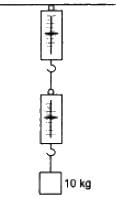
Explanation
Both the scales will read 10 kg.
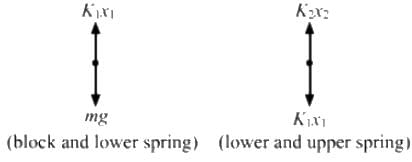
From the free-body diagram
K1x1 = mg = 10 x 9.8 = 98 N
K2x2 = K1x1
So, K1x1 = K2x2 = 98 N
Therefore, both the spring balances will read the same mass, i.e. 10 kg.
Report a problem
Question for HC Verma Questions and Solutions: Chapter 5- Newton's Laws of Motion- 1
Try yourself:A block of mass m is placed on a smooth inclined plane of inclination θ with the horizontal. The force exerted by the plane on the block has a magnitude.
Explanation
mg cosθ

From the free-body diagram,
N = mg cosθ
Normal force exerted by the plane on the block is mg cosθ.
Report a problem
Question for HC Verma Questions and Solutions: Chapter 5- Newton's Laws of Motion- 1
Try yourself:A block of mass m is placed on a smooth wedge of inclination θ. The whole system is accelerated horizontally so that the block does not slip on the wedge. The force exerted by the wedge on the block has a magnitude.
Explanation

Free-body Diagram of the Small Block of Mass 'm'
The block is at equilibrium w.r.t. to wedge. Therefore,
mg sinθ = ma cosθ
⇒ a = gtanθ
Normal reaction on the block is
N = mg cosθ + ma sinθ
Putting the value of a, we get:
N = mg cosθ + mg tanθsinθ

Report a problem
Question for HC Verma Questions and Solutions: Chapter 5- Newton's Laws of Motion- 1
Try yourself:Neglect the effect of rotation of the earth. Suppose the earth suddenly stops attracting objects placed near its surface. A person standing on the surface of the earth will.
Explanation
If the earth suddenly stops attracting objects placed near its surface, the net force on the person will become zero and according to the first law of motion, the person will remain standing.
Report a problem
Question for HC Verma Questions and Solutions: Chapter 5- Newton's Laws of Motion- 1
Try yourself:Three rigid rods are joined to form an equilateral triangle ABC of side 1 m. Three particles carrying charges 20 μC each are attached to the vertices of the triangle. The whole system is at rest in an inertial frame. The magnitude of the resultant force on the charged particle at A is.
Explanation
Using, Fnet = ma,
a = 0 ⇒ Fnet = 0
As the whole system is at rest, the resultant force on the charged particle at A is zero.
Report a problem
Question for HC Verma Questions and Solutions: Chapter 5- Newton's Laws of Motion- 1
Try yourself:A force F1 acts on a particle accelerating it from rest to a velocity v. Force F1 is then replaced by F2 which decelerates the particle to rest.
Explanation
Any force applied in the direction opposite the motion of the particle decelerates it to rest.
Report a problem
Question for HC Verma Questions and Solutions: Chapter 5- Newton's Laws of Motion- 1
Try yourself:Two objects A and B are thrown upward simultaneously with the same speed. The mass of A is greater than that of B. Suppose the air exerts a constant and equal force of resistance on the two bodies.
Explanation
Let the air exert a constant resistance force = F (in downward direction).
Acceleration of particle A in downward direction due to air resistance, aA = F/mA.
Acceleration of particle B in downward direction due to air resistance, aB = F/mB.
mA > mB
aA < aB
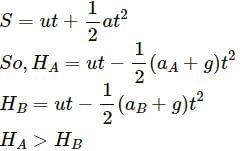
Therefore, A will go higher than B.
Report a problem
Question for HC Verma Questions and Solutions: Chapter 5- Newton's Laws of Motion- 1
Try yourself:A smooth wedge A is fitted in a chamber hanging from a fixed ceiling near the earth's surface. A block B placed at the top of the wedge takes time T to slide down the length of the wedge. If the block is placed at the top of the wedge and the cable supporting the chamber is broken at the same instant, the block will.
Explanation
Downward gravitational force will be balanced by the upward pseudo force (because of the motion of the wedge in downward direction). The block will remain at its position, as both the box and the inclined plane are falling with the same acceleration (g).
Report a problem
Question for HC Verma Questions and Solutions: Chapter 5- Newton's Laws of Motion- 1
Try yourself:In an imaginary atmosphere, the air exerts a small force F on any particle in the direction of the particle's motion. A particle of mass m projected upward takes time t1 in reaching the maximum height and t2 in the return journey to the original point. Then.
Explanation
Let acceleration due to air resistance force be a.
Let H be maximum height attained by the particle.
Direction of air resistance force is in the direction of motion.
In the upward direction of motion,

In the downward direction of motion,
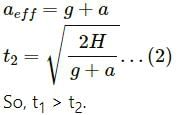
Report a problem
Question for HC Verma Questions and Solutions: Chapter 5- Newton's Laws of Motion- 1
Try yourself:A person standing on the floor of an elevator drops a coin. The coin reaches the floor of the elevator in time t1 if the elevator is stationary and in time t2 if it is moving uniformly. Then
Explanation
After the coin is dropped, the only force acting on it is gravity, which is same for both the cases.
So t1 = t2.
Report a problem
Question for HC Verma Questions and Solutions: Chapter 5- Newton's Laws of Motion- 1
Try yourself:A free 238U nucleus kept in a train emits an alpha particle. When the train is stationary, a nucleus decays and a passenger measures that the separation between the alpha particle and the recoiling nucleus becomes x at time t after the decay. If the decay takes place while the train is moving at a uniform velocity v, the distance between the alpha particle and the recoiling nucleus at a time t after the decay, as measured by the passenger, is
Explanation
The moving train does not put any extra force on the alpha particle and the recoiling nucleus. So, the distance between the alpha particle and the recoiling nucleus at a time t after the decay, as measured by the passenger, will be same as before, i.e. x.
Report a problem
*Multiple options can be correct
Question for HC Verma Questions and Solutions: Chapter 5- Newton's Laws of Motion- 1
Try yourself:A reference frame attached to the earth
Explanation
A reference frame attached to the earth cannot be an inertial frame because the earth is revolving around the sun and also rotating about its axis.
*Multiple options can be correct
Question for HC Verma Questions and Solutions: Chapter 5- Newton's Laws of Motion- 1
Try yourself:A particle stays at rest as seen in a frame. We can conclude that
Explanation
According to Newton's second law which says that net force acting on the particle is equal to rate of change of momentum ( or mathematically F = ma), so if a particle is at rest then Fnet = ma = m
Now, if the frame is inertial, then the resultant force on the particle is zero.
If the frame is non-inertial, vector sum of all the forces plus a pseudo force is zero.
i.e. Fnet ≠ 0.
*Multiple options can be correct
Question for HC Verma Questions and Solutions: Chapter 5- Newton's Laws of Motion- 1
Try yourself:A particle is found to be at rest when seen from a frame S1 and moving with constant velocity when seen from another frame S2. Mark out the possible options.
Explanation
S1 is moving with constant velocity w.r.t frame S2. So, if S1 is inertial, then S2 will be inertial and if S1 is non-inertial, then S2 will be non-inertial.
*Multiple options can be correct
Question for HC Verma Questions and Solutions: Chapter 5- Newton's Laws of Motion- 1
Try yourself:The figure shows the displacement of a particle going along the X-axis as a function of time. The force acting on the particle is zero in the region
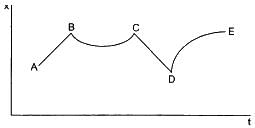
Explanation
Slope of the x-t graph gives velocity. In the regions AB and CD, slope or velocity is constant, i.e. acceleration is zero. Hence, from the second law, force is zero in these regions.
Question for HC Verma Questions and Solutions: Chapter 5- Newton's Laws of Motion- 1
Try yourself:The figure shows a heavy block kept on a frictionless surface and being pulled by two ropes of equal mass m. At t = 0, the force on the left rope is withdrawn but the force on the right end continues to act. Let F1 and F2 be the magnitudes of the forces exerted by right rope and the left rope on the block, respectively.

Explanation
At t < 0, the block is in equilibrium in the horizontal direction.
So, F1 = F2 = F
At t > 0, F2 = 0 and F1 = F.
Report a problem
*Multiple options can be correct
Question for HC Verma Questions and Solutions: Chapter 5- Newton's Laws of Motion- 1
Try yourself:The force exerted by the floor of an elevator on the foot of a person is more than the weight of the person if the elevator is
Explanation
It means normal force exerted by the floor of the elevator on the person is greater that the weight of the person.
i.e. N > mg
(i) Going up and speeding up:
aeff = g + a
N = maeff = mg + ma (N > mg)
(ii) Going down and speeding up:
aeff = g – a
N = mg – ma (N < mg)
(iii) Going down and slowing down:
aeff = g – (–a) = g + a
N = mg + ma (N > mg)
(iv) Going up and slowing down:
aeff = g – a
N = mg – ma (N < mg)
*Multiple options can be correct
Question for HC Verma Questions and Solutions: Chapter 5- Newton's Laws of Motion- 1
Try yourself:If the tension in the cable supporting an elevator is equal to the weight of the elevator, the elevator may be
Explanation
Tension in the cable = Weight of the elevator
Or, total upward force = total downward force
That is, there's no acceleration or uniform velocity.
So, the elevator is going up/down with uniform speed.
Question for HC Verma Questions and Solutions: Chapter 5- Newton's Laws of Motion- 1
Try yourself:A particle is observed from two frames S1 and S2. Frame S2 moves with respect to S1 with an acceleration a. Let F1 and F2 be the pseudo forces on the particle when seen from S1 and S2, respectively. Which of the following is not possible?
Explanation
F1 = 0, F2 = 0

Acceleration of the particle w.r.t. to S1 = F1/m
Acceleration of the particle w.r.t. to S2 = F2/m
If we assume F1 = 0 and F2 = 0,
we can conclude that

From equations (1) and (2), we can say that our assumption is wrong.
And F1 = 0, F2 = 0 is not possible.
Report a problem
Question for HC Verma Questions and Solutions: Chapter 5- Newton's Laws of Motion- 1
Try yourself:A person says that he measured the acceleration of a particle to be non-zero even though no force was acting on the particle.
Explanation
If no force is acting on a particle and yet, its acceleration is non-zero, it means the observer is in a non-inertial frame.
Report a problem

when it is moving on the inclined plane, the tension is mg. So, by measuring the tension in the string we can differentiate between the two cases.





































